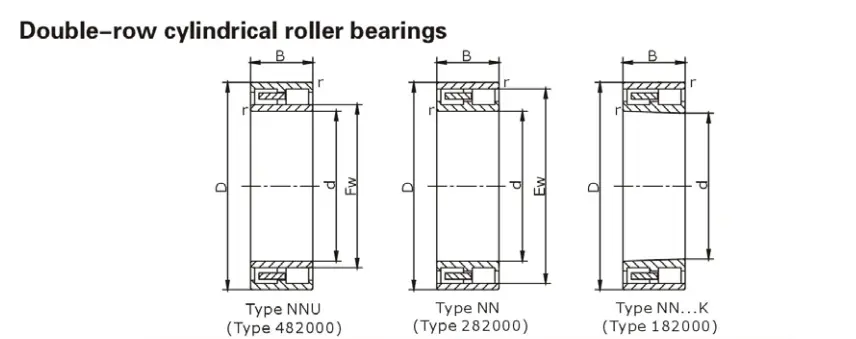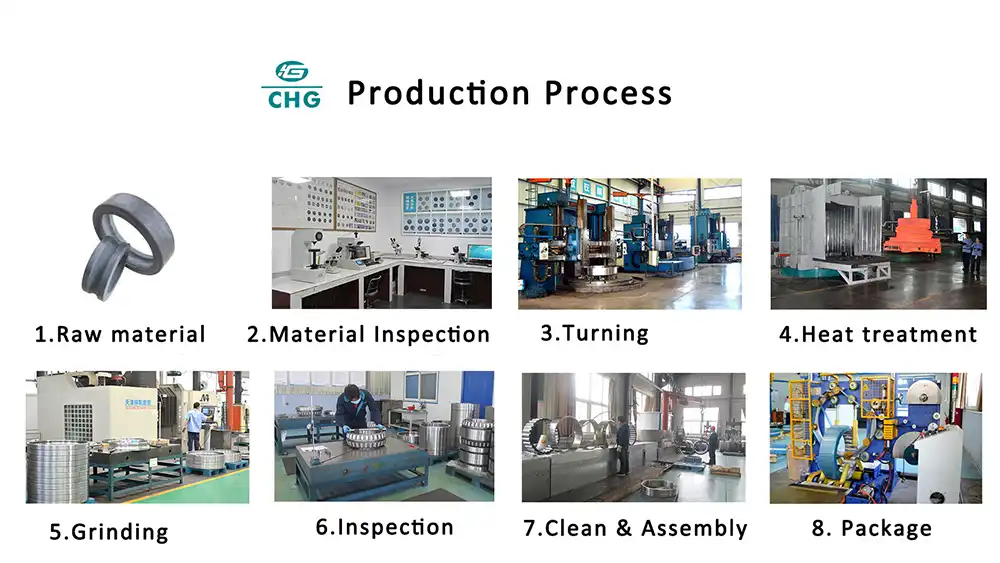What are the Advantages of Double Row Bearings?
Double row bearings are a crucial component in many industrial applications, offering significant benefits over their single row counterparts. These bearings consist of two rows of rolling elements, typically balls or rollers, arranged in a way that allows them to handle both radial and axial loads effectively. The design of double row bearings provides enhanced stability, increased load capacity, and improved performance in various operating conditions. This blog post will explore the advantages of double row bearings, with a focus on double row cylindrical roller bearings, and answer some common questions about their applications and benefits.

What are the key differences between single and double row cylindrical roller bearings?
Single row cylindrical roller bearings and double row cylindrical roller bearings share some similarities, but their design and capabilities set them apart in significant ways. The primary difference lies in their structure: single row bearings have one row of rollers, while double row bearings feature two parallel rows of rollers within the same bearing assembly.
This structural difference leads to several key advantages for double row cylindrical roller bearings:
1. Increased Load Capacity: Double row bearings can handle substantially higher loads compared to single row bearings of similar size. The additional row of rollers effectively distributes the load over a larger surface area, allowing the bearing to withstand greater radial and axial forces. This increased load capacity makes double row bearings ideal for heavy-duty applications in industries such as mining, steel production, and heavy machinery manufacturing.
2. Enhanced Stability: The two rows of rollers provide better stability and alignment, particularly under varying or complex load conditions. This improved stability reduces vibration and helps maintain precise positioning of rotating shafts or components, which is crucial in applications requiring high accuracy, such as machine tools or precision equipment.
3. Improved Rigidity: Double row bearings offer greater rigidity due to their design. The parallel rows of rollers create a wider effective bearing width, increasing the overall stiffness of the bearing assembly. This enhanced rigidity is particularly beneficial in applications where minimal deflection is required, such as in high-speed machinery or equipment subject to frequent start-stop cycles.
4. Better Handling of Moment Loads: Double row cylindrical roller bearings are more capable of handling moment loads or tilting moments compared to single row bearings. This ability stems from the wider spacing between the roller rows, which provides a larger lever arm to resist tilting forces. This feature is particularly valuable in applications where shafts may experience bending or misalignment, such as in gearboxes or wind turbine drivetrains.
5. Compact Design: Despite offering higher load capacity and improved performance, double row bearings often provide these benefits within a relatively compact package. This space-saving design allows engineers to create more efficient and streamlined machinery without sacrificing performance or durability.
While double row cylindrical roller bearings offer these advantages, it's important to note that the choice between single and double row bearings depends on the specific application requirements. Factors such as load characteristics, speed, space constraints, and cost considerations all play a role in determining the most suitable bearing type for a given application.
How do double row cylindrical roller bearings improve machinery performance?
Double row cylindrical roller bearings contribute significantly to improved machinery performance across various industries. Their unique design and capabilities enhance several aspects of mechanical systems, leading to more efficient, reliable, and productive operations.
1. Enhanced Load Handling: The primary way double row cylindrical roller bearings improve machinery performance is through their superior load-handling capabilities. These bearings can support higher radial loads and moderate axial loads simultaneously, allowing machinery to operate under more demanding conditions. This increased load capacity enables the design of more powerful and efficient equipment, particularly in heavy industries such as mining, construction, and steel manufacturing.
2. Reduced Friction and Heat Generation: Despite their higher load capacity, double row cylindrical roller bearings often generate less friction compared to other bearing types under heavy loads. The cylindrical rollers provide line contact with the raceways, distributing the load over a larger area. This reduced contact pressure results in lower friction, which in turn leads to less heat generation during operation. Lower operating temperatures contribute to extended lubricant life, reduced energy consumption, and improved overall efficiency of the machinery.
3. Improved Rotational Accuracy: The dual rows of rollers in these bearings provide better support and guidance for rotating shafts, resulting in improved rotational accuracy. This enhanced precision is crucial in applications such as machine tools, where even minor deviations can affect the quality of the finished product. The increased stiffness and stability offered by double row bearings help maintain tight tolerances and ensure consistent performance, even under varying load conditions.
4. Vibration Reduction: Double row cylindrical roller bearings are effective at reducing vibration in rotating machinery. The two rows of rollers provide better damping characteristics, helping to absorb and dissipate vibrations that can occur due to imbalances, misalignments, or external forces. Reduced vibration leads to smoother operation, less wear on components, and improved product quality in manufacturing processes.
5. Higher Speed Capabilities: While not typically designed for the highest speeds, double row cylindrical roller bearings can often operate at higher speeds than some other types of bearings with similar load capacities. Their design allows for effective lubrication and heat dissipation, enabling machinery to run at increased speeds without compromising reliability. This capability is particularly beneficial in applications where both high loads and moderate to high speeds are required, such as in industrial gearboxes or rolling mill equipment.
6. Increased Uptime and Reliability: The robustness and durability of double row cylindrical roller bearings contribute to increased machinery uptime and overall reliability. Their ability to handle heavier loads and withstand challenging operating conditions means they are less likely to fail prematurely. This reliability translates to reduced maintenance requirements, fewer unexpected breakdowns, and lower overall operating costs for industrial equipment.
By improving these various aspects of machinery performance, double row cylindrical roller bearings play a crucial role in advancing industrial capabilities. They enable the design of more powerful, efficient, and reliable equipment, contributing to increased productivity and reduced operational costs across a wide range of industries.
What are the common applications of double row cylindrical roller bearings?

Double row cylindrical roller bearings find widespread use across numerous industries due to their exceptional load-carrying capacity, stability, and reliability. Their unique design makes them particularly suitable for applications that demand high performance under challenging conditions. Here are some of the most common applications of double row cylindrical roller bearings:
1. Heavy Industry and Mining Equipment: In the mining and heavy industry sectors, double row cylindrical roller bearings are essential components in various types of machinery. They are commonly used in:
- Crushers and grinding mills: These bearings support the heavy loads and shock loads experienced in ore crushing and grinding operations.
- Conveyor systems: Large conveyor pulleys often utilize double row bearings to handle the combination of heavy loads and potential misalignment.
- Excavators and draglines: The swing bearings and drive components in these massive machines rely on double row bearings for their load capacity and durability.
2. Steel and Metal Processing Industry: The steel industry places extreme demands on bearings due to high temperatures, heavy loads, and the presence of contaminants. Double row cylindrical roller bearings are used in:
- Rolling mills: Both work rolls and back-up rolls in hot and cold rolling mills benefit from the high load capacity and stability of these bearings.
- Continuous casting machines: The roller tables and segment rollers in these machines require bearings that can withstand high temperatures and loads.
- Furnace equipment: Various components in steel processing furnaces use these bearings for their ability to handle thermal expansion and high temperatures.
3. Wind Turbines: The renewable energy sector, particularly wind power, has become a significant user of double row cylindrical roller bearings. They are employed in:
- Main shaft bearings: Supporting the rotor and handling the varying loads caused by wind conditions.
- Gearbox bearings: Managing the high torques and speeds within wind turbine gearboxes.
- Generator bearings: Ensuring smooth and efficient power generation under variable operating conditions.
4. Paper and Pulp Industry: The paper manufacturing process involves heavy rolls and high-speed operations, making it an ideal application for double row bearings:
- Paper machine rolls: Including press rolls, dryer rolls, and calender rolls, which require high load capacity and precision.
- Pulp refiners: Handling the high radial and axial loads in pulp processing equipment.
5. Machine Tools and Manufacturing Equipment: Precision and stability are crucial in machining operations, making double row bearings valuable in:
- Spindle assemblies: Providing the necessary rigidity and accuracy for high-speed cutting operations.
- Rotary tables: Supporting heavy workpieces while maintaining precision in multi-axis machining centers.
- Industrial robots: Offering stability and load capacity in robotic arm joints and actuators.
6. Automotive Industry: While less common in passenger vehicles, double row cylindrical roller bearings are used in:
- Heavy-duty truck wheel hubs: Providing durability and load capacity for commercial vehicles.
- Transmission systems: Supporting gears and shafts in heavy-duty vehicle transmissions.
These applications highlight the versatility and importance of double row cylindrical roller bearings across various industries. Their ability to handle heavy loads, provide stability, and operate reliably in challenging environments makes them indispensable components in many critical machines and systems. As industrial technology continues to advance, these bearings will likely find even more applications, contributing to improved efficiency and performance in numerous sectors.
In conclusion, the advantages of double row bearings, particularly double row cylindrical roller bearings, make them invaluable components in modern machinery. Their superior load capacity, enhanced stability, and improved performance characteristics contribute significantly to the efficiency, reliability, and longevity of equipment across various industries. As engineering challenges continue to evolve, the role of these advanced bearing solutions in driving industrial progress remains crucial.
Luoyang Huigong Bearing Technology Co., Ltd. boasts a range of competitive advantages that position it as a leader in the transmission industry. Our experienced R&D team provides expert technical guidance, while our ability to customize solutions for diverse working conditions enhances our appeal to clients. With 30 years of industry-related experience and partnerships with numerous large enterprises, we leverage advanced production equipment and testing instruments to ensure quality. Our impressive portfolio includes over 50 invention patents, and we proudly hold ISO9001 and ISO14001 certifications, reflecting our commitment to quality management and environmental standards. Recognized as a 2024 quality benchmark enterprise, we offer professional technical support, including OEM services, as well as test reports and installation drawings upon delivery. Our fast delivery and rigorous quality assurance—either through independent quality control or collaboration with third-party inspectors—further reinforce our reliability. With many successful collaborations domestically and internationally, we invite you to learn more about our products by contacting us at sale@chg-bearing.com or calling our hotline at +86-0379-65793878.
References
1. SKF Group. (2024). Cylindrical roller bearings.
2. Timken Company. (2023). Double-Row Cylindrical Roller Bearings.
3. NSK Ltd. (2024). Cylindrical Roller Bearings.
4. Schaeffler Technologies AG & Co. KG. (2023). Cylindrical roller bearings.
5. NTN Corporation. (2024). Cylindrical Roller Bearings.
6. Journal of Mechanical Engineering Science. (2022). "Performance analysis of double-row cylindrical roller bearings under combined loads." Vol. 236, Issue 10, pp. 5123-5138.
7. Tribology International. (2023). "Experimental investigation on the lubrication performance of double-row cylindrical roller bearings at high speeds." Vol. 170, 107523.
8. Mechanism and Machine Theory. (2021). "Dynamic modeling and analysis of a double-row cylindrical roller bearing considering cage flexibility." Vol. 156, 104139.
9. Wear. (2022). "Influence of roller profile modification on the performance of double-row cylindrical roller bearings." Vol. 488-489, 204155.
10. International Journal of Mechanical Sciences. (2023). "Thermal-mechanical coupling analysis of high-speed double-row cylindrical roller bearings considering centrifugal expansion." Vol. 246, 107998.

